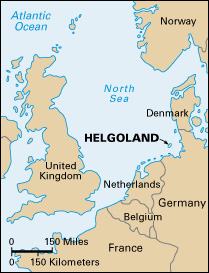Helgoland is an island in the North Sea off the northwest coast of Germany. It belongs to Germany and covers about 11/2 square miles (4 square kilometers). It has a population of about 1,400.

Denmark claimed Helgoland during the 1700’s and early 1800’s, and the United Kingdom claimed it for much of the 1800’s. The British returned Helgoland to Germany in 1890 in exchange for Zanzibar in Africa.
At the start of World War I (1914-1918), Germany moved Helgoland’s people to the German mainland and made the island into a naval base. The Treaty of Versailles, which officially ended the war, ordered the destruction of the island’s fortifications (defense structures).
In the 1930’s, Germany rebuilt Helgoland’s fortifications and naval base. The island became strategically important during World War II (1939-1945). In 1947, the British Navy set off thousands of tons of high explosives to destroy the island’s submarine pens, underground fortifications, and other military installations.
In 1952, Helgoland was returned to West Germany (now part of Germany). The Germans resettled the island and built it into a resort area.
